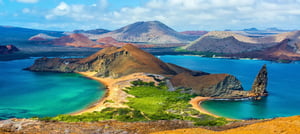
BARTOLOME ISLAND
The Pinnacle Rock, formed by an eroded toba cone, is the most emblematic formation of the archipelago. On its base, a small colony of Penguins cohabit with Sea Lions and Marine Birds. On the visit site of the beach, one can observe juvenile sharks swimming along the shore line, and sometimes on the surroundings, a hawk domains the air. Great snorkeling opportunities with penguins and sea lions off a golden-sand beach at the foot of popular Pinnacle Rock.
Visit site: View point, beach and Pinnacle.
Animals: penguins, sharks, herons, hawks, rays, finches.
Plants: Pioneer plants, Tiquilia, Chamaesyce, Scalesia Stewartii, mangroves, dune vegetation.
Ready for your adventure?
Dive into nature with us and see what makes these islands unique.
Tap below to get started!
VISITOR SITES
Bartolome
Located at the center of the archipelago, Bartolome is one of the most frequently visited sites of all the islands. The highest point is only 374 ft (114 m) above sea level and it is separated from the island of Santiago by Sullivan Bay. The island has a surface area of 0.74 mi (1.2 km) It is an excellent site for snorkeling, filled with the breathtaking volcanic landscapes that make this corner of the world so unique.
We have two landing possibilities: a dock and a beach. The dock, made out of lava and concrete, soon turns into a wooden staircase built to avoid erosion and consists of 372 steps. It takes us to the island’s summit, where we find what probably constitutes the most photographed site in the Galapagos: Pinnacle Rock.
Due to its altitude, the lack of vegetation is immediately noticeable. Pioneer plants are observed, they are called this way because they are the first to establish roots on new ground. They include Tiquilia nesiotica (which is endemic to the island) and Chamaesyce (known as sand mat or spurge in English), lava cactus, and Scalesia bushes. Behind the beach, we have the dunes covered by mangroves.
The coralline beach next to Pinnacle Rock is a wet landing site from which we are able to snorkel amongst tropical fish and perhaps sea lions and penguins; they rest on the lava of the intertidal zone and sometimes decide to take a dip.

- Disembarking: Dry.
- Type of Terrain: Wooden Trail.
- Difficulty: Medium.
- Activities: 25 min glass-bottom boat / 45 min beach snorkeling / 30 min dinghy ride / 45 min hike.
- Highlights: We will travel back in time to the formation of lava tubes, spatter cones and the remains of two types of hardened lava: AA and pahoehoe. Beautiful and breathtaking landscapes as you climb up Summit Trail. During the ascent, visitors will see Tiquilia and various cactus species, which add to the unique experience. The tall, leaning spike known as Pinnacle Rock is always something to behold. For many visitors, this may turn out to be the best of snorkeling experiences. There is a possibility to swim with zigzagging penguins that are chasing small schools of fish or see them sitting on the rocks during your dinghy ride.
Wildlife by visitor site
MARINE IGUANA
SEA LION
Gallery
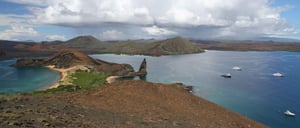


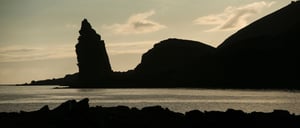

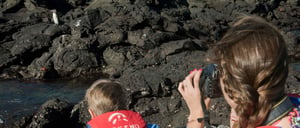
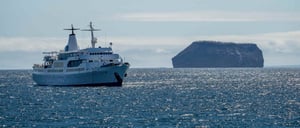
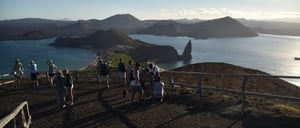

Suggested items
CAP
Location map

CHARLES DARWIN JOURNEY
This is the first Island visited by Charles Darwin, and his first impression of the dry coast he saw was of a deserted and isolated place. He did not find the tropical richness he expected, but he had the chance to collect the first specie that later on would be the start of his Theory of Evolution, the San Cristobal Mockingbird.